|
STATES |
DETAILS/RESULTS/ACTIONS |
|
A1: CHECK THE POWER CIRCUIT OF THE TRANSMITTER - ELECTRICAL CIRCUIT 15-GL37A (GREEN/BLACK) |
|
|
1 Enter the OFF position. |
|
|
2 Disconnect the PATS Transmitter - C390. |
|
|
3 Drive the ON position. |
|
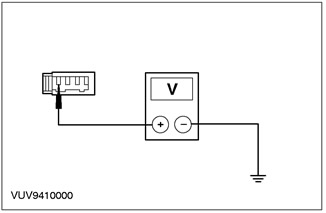
|
4 Using a digital multimeter, measure the voltage between pin 1 C390 of the PATS transmitter, circuit 15-GL37A (green/black), from the wiring side and "weight". |
|
• Is the voltage over 10 V? |
|
|
→ Yes |
|
|
Go to A2 |
|
|
→ No |
|
|
REPAIR Circuit 15-GL37A (green/black). REPEAT the self test. CLEAR DTCs. |
|
|
A2: CHECK TRANSMITTER GROUND CIRCUIT FOR OPEN - 91-GL1 CIRCUIT (BLACK/YELLOW) |
|
|
1 Enter the OFF position. |
|
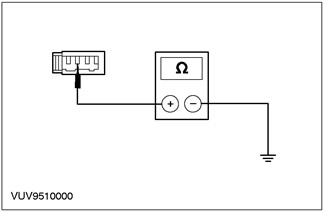
|
2 Using a DMM, measure the resistance between C390 pin 2 of the PATS transmitter, circuit 91-GL1 (black/yellow), from the wiring side and "weight". |
|
• Is the resistance less than 5 ohms? |
|
|
→ Yes |
|
|
Go to A3 |
|
|
→ No |
|
|
REPAIR Circuit 91-GL1 (black/yellow). REPEAT the self test. CLEAR DTCs. |
|
|
A3: CHECK VOLTAGE ON PATS TRANSMITTER - ELECTRICAL CIRCUIT 8-GL37 (WHITE/GREEN) |
|
|
1 Drive the ON position. |
|
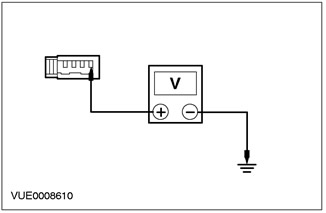
|
2 Using a digital multimeter, measure the voltage between pin 4 C390 of the PATS transmitter, circuit 8-GL37 (white/green), from the wiring side and "weight". |
|
• Is the voltage over 10 V? |
|
|
→ Yes |
|
|
Go to A5 |
|
|
→ No |
|
|
Go to A4 |
|
|
A4: INSPECT ELECTRICAL CIRCUIT 8-GL37 (WHITE/GREEN) BREAK |
|
|
NOTE: Installing a new PCM requires reprogramming coded ignition keys |
|
|
1 Enter the OFF position. |
|
|
2 Disconnect PCM C415. |
|
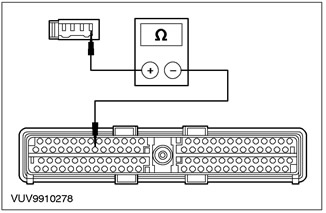
|
3 Using a DMM, measure the resistance between pin 4 C390 of the PATS transmitter, circuit 8-GL37 (grey/orange), on the wiring side, and pin 53 C415 of the PCM, on the wiring side. |
|
• Is the resistance over 10,000 ohms? |
|
|
→ Yes |
|
|
INSTALL a new PCM. See Section 303-14 for more information. REPROGRAM coded ignition keys. For more information, refer to Key Programming available in this section. REPEAT the self test. CLEAR DTCs. |
|
|
→ No |
|
|
REPAIR circuit 8-GL37 (white/green). CLEAR DTCs. REPEAT the self test. CHECK the system is working properly. |
|
|
A5: CHECK THE VOLTAGE IN THE TRANSMISSION CIRCUIT OF THE TRANSMITTER - ELECTRICAL CIRCUIT 10-GL37 (GRAY/ORANGE) |
|
|
1 Connect PCM - C415. |
|
|
2 Connect the PATS Transmitter - C390. |
|
|
3 Enter the OFF position. |
|
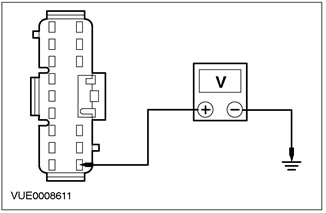
|
4 Using a digital multimeter, measure the voltage by gently touching the probe between pin 1 C63, circuit 10-GL37 (grey/orange), And "weight". |
|
• Is the voltage over 8V? |
|
|
→ Yes |
|
|
Go to A7 |
|
|
→ No |
|
|
Go to A6 |
|
|
A6: CHECK TRANSMISSION ELECTRICAL CIRCUIT FOR OPEN - ELECTRICAL CIRCUIT 10-GL37 (GRAY/ORANGE) |
|
|
1 Disconnect Line connector - C63. |
|
|
2 Disconnect Transmitter - C390. |
|
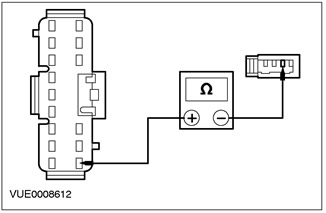
|
3 Using a DMM, measure the resistance between pin 3 C390 of the PATS transmitter, circuit 10-GL37 (grey/orange), on the wiring side, and pin 1 C63, on the wiring side. |
|
• Is the resistance less than 5 ohms? |
|
|
→ Yes |
|
|
INSTALL a new PATS transmitter. For more information refer to Module - Transmitter available in this section. REPEAT the self test. Clear DTCs. |
|
|
→ No |
|
|
REPAIR circuit 10-GL37 (gray/orange). CHECK the system is working properly. |
|
|
A7: CHECK TRANSMITTER RECEIVE CIRCUIT FOR OPEN - CIRCUIT 10-GL37 (GRAY/ORANGE) |
|
|
1 Enter the OFF position. |
|
|
2 Disconnect PCM C415. |
|
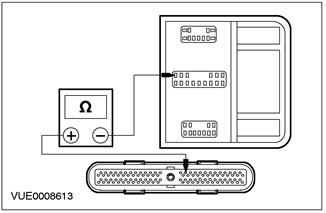
|
3 Using a DMM, measure the resistance between PCM pin 15 C415, circuit 10-GL37 (grey/orange), on the wiring side, and pin 11 C61, on the wiring side. |
|
• Is the resistance less than 5 ohms? |
|
|
→ Yes |
|
|
INSTALL a new PCM. See Section 303-14 for more information. REPROGRAM coded ignition keys. For more information, refer to Key Programming available in this section. REPEAT the self test. Clear DTCs. |
|
|
→ No |
|
|
REPAIR circuit 10-GL37 (gray/orange). REPEAT the self test. CLEAR DTCs. CHECK the system is working properly. |
|
PINPOINT TEST B: ANTI-THEFT SYSTEM FAILURE - ENGINE DOES NOT TURN BUT THE ANTI-THEFT LED CORRECTLY DISPLAYS SYSTEM STATUS.
|
STATES |
DETAILS/RESULTS/ACTIONS |
|
B1: CHECK STARTER SYSTEM GROUND |
|
|
1 Enter the OFF position. |
|
|
2 Disconnect the starter relay. |
|
|
3 Drive the START position. |
|
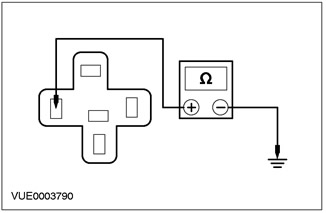
|
4 Using a DMM, measure the resistance between pin 2 of the start inhibit relay, circuit 31S-BB16 (black/red), from the wiring side, and "weight", while holding the key in position III. |
|
• Is the resistance less than 5 ohms? |
|
|
→ Yes |
|
|
PERFORM DIAGNOSIS on the starting system. See Section 303-06 for more information. |
|
|
→ No |
|
|
Navigate to B2 |
|
|
B2: INSPECT ELECTRICAL CIRCUIT 31S-BB16 (BLACK/RED) BREAK |
|
|
NOTE: When installing a new PCM, the coded ignition key must be reprogrammed. TURN the ignition switch to the OFF position, then to the ON position. UPLOAD the DTCs. If PATS DTCs are set, GO to Diagnostic Trouble Code List (DTC) Powertrain control module (PCM). If no DTCs are set, the PATS system is OK. |
|
|
1 Enter the OFF position. |
|
|
2 Disconnect PCM C415. |
|
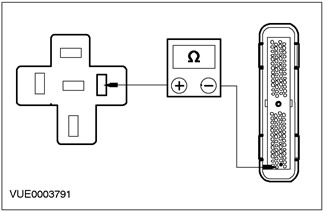
|
3 Using a DMM, measure the resistance between PCM pin 27 C415 (use pin 32 on the 60 pin PCM connector) and pin 2 start inhibit relay, circuit 31S-BB16 (black/red). |
|
• Is the resistance less than 5 ohms? |
|
|
→ Yes |
|
|
INSTALL a new PCM. See Section 303-14 for more information. REPROGRAM coded ignition keys. For more information, refer to Key Programming available in this section. CHECK the system is working properly. |
|
|
→ No |
|
|
REPAIR circuit 31S-BB16 (black/red). CHECK the system is working properly. |
|
Visitor comments